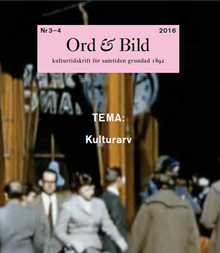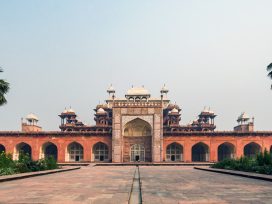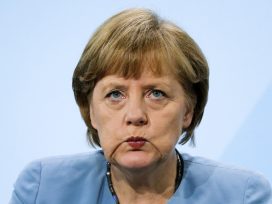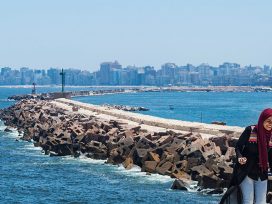People are formed by cultural heritage, or what others presume their cultural heritage to be. Cultural heritage is, in turn, formed by people. Some don’t need to explain who they are or where they come from; the national and local heritage is seen as a natural part of their own cultural identity. They have great freedom to form their own relations to cultural heritage – they can pick and choose. For others, heritage is something that is queried and misinterpreted, if it is recognized at all. A particular heritage is often implicated to them even if they have no close relation to it. These differences naturally affect people’s ability to express themselves and to participate fully as citizens in their nation state. The full impact of this is hard to grasp for those who have no experience of being constantly questioned and asked to explain how they relate to cultural heritage, since it is assumed that they have another heritage.
Sweden’s multicultural recent history
 For those outside the narrow circles of curators and preservationists, cultural heritage is in many ways a new issue. Twenty years ago, public debate in Sweden focused on the fluidity of identities. Choosing, changing and transforming your identity was seen as desirable and unproblematic. Identities were not understood as being connected to cultural heritage. When Sweden celebrated the ‘Year of Multiculturalism’ ten years ago, the events consisted almost exclusively of enactments of ethnic culture, leading to severe criticism from postmodern circles. Today, postmodernism has itself been discredited. Instead, tradition and heritage have come to the fore of public debate, and identities are again understood as being deeply anchored in elusive cultural entities whose origins and limits no one can really describe. Religious identities, particularly for all those not seen as Swedes, have also become prominent in a way that few would have expected twenty years ago.
For those outside the narrow circles of curators and preservationists, cultural heritage is in many ways a new issue. Twenty years ago, public debate in Sweden focused on the fluidity of identities. Choosing, changing and transforming your identity was seen as desirable and unproblematic. Identities were not understood as being connected to cultural heritage. When Sweden celebrated the ‘Year of Multiculturalism’ ten years ago, the events consisted almost exclusively of enactments of ethnic culture, leading to severe criticism from postmodern circles. Today, postmodernism has itself been discredited. Instead, tradition and heritage have come to the fore of public debate, and identities are again understood as being deeply anchored in elusive cultural entities whose origins and limits no one can really describe. Religious identities, particularly for all those not seen as Swedes, have also become prominent in a way that few would have expected twenty years ago.
Swedes themselves are often portrayed as a people without a culture. The official nationalism of the Swedish welfare state did not concern itself with Swedish culture; instead, it took pride in Swedish social development, in Swedish society being modern and rational. This wasn’t considered nationalism, since nationalism was considered irrational and anti-modern. Today, those who want to emphasize Swedish culture and identity still have a hard time delineating themselves from the far-Right, that is to say the Sweden Democrats and other irrational chauvinists.
This is not to say that thirty years ago there were not people who wanted to ‘keep Sweden Swedish’, even if they had difficulties defining Swedishness and what threatened to make it un-Swedish. The organization ‘Keep Sweden Swedish’ claimed that the threat came from immigrants. Immigrants were called blattar (‘wogs’); one explanation for the danger they were presumed to pose was that they weren’t of the Swedish or Nordic race. But apart from being un-Swedish and having dark hair, they had little in common. They were Turks, Somalis, Bosnians, Macedonians, Croats, Serbs, Arabs, Chileans, and other nationalities that few had ever heard of. Then something shifted. In Europe, the symbol of this shift is often seen as the Rushdie affair of 1989. Different groups of immigrants that previously had not been considered to have much in common suddenly appeared to be a large homogenous group: Muslims. The vague foreign threat now had a face. The opposite of Swedishness, of being European, of all that was modern and civilized, was Islam. In 1989, it seemed to become obvious how different they were. They burned books. Ayatollah Khomeini, who was seen to be speaking for the whole Muslim world, pronounced a death sentence on a successful postmodern writer, one of the leading exponents of the notion of fluid and hybrid identities.
However, the belief that Islam is the antithesis of modern, secular, European identity was not based solely on the violent reaction of some Muslims to Salman Rushdie’s novel The Satanic Verses, nor was it a sole result of the fact that Europe had recently received many newcomers with a Muslim cultural background and a possible Muslim religious identity and practice. Islam has in many ways always been the preferred opposite of Europe.
Islam in Europe
The term ‘Europeans’ appeared during the Carolingian renaissance in the eighth century. Its first mention is in a chronicle of 754 describing those who defeated a Muslim army at Poitiers in 732 as ‘europenses’. From the outset, Europe was understood in relation to Islam, with Islam as the enemy that created European unity. In Muslim chronicles, the battle of Poitiers is barely mentioned, despite its mythologization as the birthplace of Europe and salvation of Christianity in western history. From the arrival of Muslim troops at Gibraltar in 711 to the fall of the Umayyad dynasty in 750, when the Abbasid dynasty took over the large Muslim caliphate, there was near-continuous fighting in the Pyrenean regions. The Abbasids moved their capital from Damascus to Baghdad and directed their main interests eastward to the Persian regions of the empire. Before this, Berber uprisings during the 740s had created turbulence in North Africa. In classical Muslim historiography, the halt of Muslim expansion into western Europe is understood not in relation to Christian resistance but due to other, more urgent concerns elsewhere. Later, in the medieval Song of Roland, the trope of noble Christian knights fighting the cunning Muslims became a grand European saga. Enmity towards Islam is thus engraved in the very heart of the idea of Europe. But the fighting on the Iberian Peninsula did not in any simple way play out between Muslims and Christians: alliances of Muslim and Christian kingdoms often fought other inter-religious alliances.
Islam is in many ways more European than a conventional notion of ‘European heritage’ suggests. From 1362 to 1924, the Ottoman sultan bore the title of Caliph. The leader of the righteous, the formal ruler over the entire Muslim world, the deputy of the Prophet of God, lived and ruled in Europe – first in Edirne (the ancient Adrianople), then in Istanbul (the ancient Constantinople). Like the British empire, the Ottoman Empire was a European empire; the ruling elite came from Europe, even if the bulk of its territory lay outside of Europe. The Balkans were conquered by the Ottomans in the fifteenth century. Since then, large parts of the population in Bosnia, Macedonia and Albania have been Muslim.
Muslims have lived in Europe longer than that, however, even beyond the Iberian Peninsula. Islam arrived in the twelfth century to what is present-day Bulgaria, and in the fifteenth century the territory became part of the Ottoman Empire. The Tatars, who lived along the Volga, are said to have converted to Islam in the tenth century, and in the fourteenth century they came to the Baltic region, mainly Lithuania, Poland and Belarus. Some of the European countries with traditional Muslim populations include Russia, Lithuania, Poland, Belarus, Romania, Moldova, Bulgaria, Greece, Bosnia, Macedonia, Serbia, Montenegro, Kosovo, Albania, Austria, Germany and Finland (and thus also Sweden, since Finland was part of Sweden until 1809). The Polish constitution of 1791, a document informed by the European Enlightenment that has an important place in the narrative of modern Europe, stipulates representation in parliament for the local Tatar Muslims.
Ibn Fadlan, who travelled up the Volga in the early tenth century, met 5,000 members of the Baranjar family who had converted to Islam. He wrote that they had built a wooden mosque, but that he had taught them how to pray. Some have claimed that these Baranjar were Norsemen, while others claim they were Bulgarians. What we do know is that there was frequent contact between Scandinavia and Muslim lands through and along the Volga during this period. Evidence of this is the fact that Sweden holds one of the world’s largest collections of coins from the Muslim world: over 85,000 silver dirhams. Until the end of the tenth century, coins from the Muslim world were the most common type of silver in Scandinavia. A few other objects with Islamic inscriptions from this period have also been found in Sweden – for example, a ring with a stone inscribed with the name of Allah, found in a woman’s grave in the city of Birka. How close were these contacts? This is hard to tell. In any case, they belong to a Muslim cultural heritage in Sweden.
Intellectual influences from the Muslim world have also been recognized as part of the European narrative, even if Muslim society is mainly seen as having ‘brought home’ Greek heritage to Europe. Still, without those figures who in Latin were called Alkendis, Alfarabius, Algazel, Avveroes, Algoritmi, Alfraganus, Geber, Rhazes, Avicenna, and Alhazen, as well as a long line of other Muslim philosophers and scientists, there would have been no Scholasticism, no Renaissance, nor a scientific revolution, and thus no Modern Europe. Even though it is impossible to confirm counterfactual statements, this can still be asserted.
Strangely, however, none of this is considered to be part of European heritage. Europe is a term without clear objective content. It is a name that can be tied to different chains of reference and thus refer to different entities. It is seldom a merely geographical term; more often, it is connected to a collection of values, or a historically formed entity, or an identity. If one says that Islam is European, or that Islam is not European, these are ideological claims rather than historical or empirical statements. What are often referred to as European values are constructed from a heritage and a history that are shared by Islam and Christianity, a heritage that both Muslims and Christians in Europe had a part in developing.
The dominant European understanding of Europe is construed in such a way that Muslim immigrants can never really be included in it. Islam is almost always described as something that belongs outside Europe, or as something that is new to Europe, and that cannot therefore be a part of European heritage. However, it is important to see that this is a contemporary image of Europe that pertains to immigrant Muslims. Even if Muslims were already being portrayed as being suspicious and frightening during the so-called oil crisis of 1973, Islam as religion was not a particular focus of attention. The Islamic Revolution in Iran in 1979 altered this somewhat. The major threat as perceived in the West, not least in popular culture and cinema, was still communist; the terrorists and militant independence fighters of the 1970s in the Muslim world were also leftists. This changed in 1989, the year that saw the Soviets pull out of Afghanistan, having been defeated by the Mujahideen.
The Muslim tradition has also portrayed Islam as antithetical to Europe. The distinction between dar al-Islam and dar al-Harb, the land of Islam and the land of war, is sometimes cited. It expresses the understanding that all lands outside the Muslim world are a land of war, a land of Muslim expansion. To survive in the dar al-Harb, Muslims are allowed to practice taqiyah (denying one’s faith). This is a notion that has become notorious among European populists: one cannot trust Muslims, they are religiously sanctioned to keep a hidden agenda, they think. But taqiyah only allows the denial of one’s faith when under threat of severe violence; it does not sanction clandestine activity.
Yet Europe is not always seen in terms of dar al-Islam or dar al-Harb. The Sunni legal scholar Imam al-Shafi (767-820) spoke about a land of treaty (dar al-Ahd) as an alternative to the simple dichotomy between war and peace. The term described lands outside Muslim territory with which there was a regulated peace. Areas not ruled by Muslims can also be seen as lands of safety (dar al-Amn): states where Muslims are safe and where their security and religious freedom is protected. Being Muslim means, among other things, being a role model for others and giving the best possible impression of one’s religion. Tariq Ramadan, a prominent voice in contemporary discussions about what it means to be a European Muslim, has pointed out that both the opportunity to practice Islam and to act as a positive example for Islam are greater in European states than in many countries counted as dar al-Islam. In Europe, people’s right to live in relation to a Muslim cultural heritage, and to create their own interpretation of what this means, are protected by law, he notes. The Swedish welfare state has even been described as an Islamic role model.
Yet the topic of Muslim cultural heritage is more complicated till. Islam is a religion that can be found in many different cultures. The error is to tie a religion to a specific culture. As long as we think in those terms, the question as to whether someone is Muslim or European still seems plausible. Even if Europe is often defined by its Christian heritage, there are many who identify with this heritage while at the same time being fully and truly Muslim.
Cultural heritage is not Muslim
The lack of a recognized connection between Islam and the positive formulations of European identity also becomes clear when we turn to more general discussions about cultural heritage. Definitions of cultural heritage, and the arguments for why heritage matters, are narrowly western. In the key contributions to the academic discourse on cultural heritage, it is very rare to find references to Islam. In Laurajane Smith’s seminal Uses of Heritage (2006), there is no mention of Islam whatsoever; in Rodney Harrison’s Heritage: Critical Approaches (2013), a book that very much defines the growing field of critical heritage studies, the only time Islam surfaces is in a discussion on the destruction of the UNESCO World Heritage-listed Buddha statues in Bamiyan by the Afghan Taliban. Elsewhere, Islam is mentioned only in more general allusions to immigration, terrorism and other perceived threats.
One exception is Sharon Macdonald’s Memorylands: Heritage and Identity in Europe Today (2013). Macdonald stresses that it is problematic to equate European and Christian heritage. She discusses the veil in some detail as an element of Muslim heritage, and connects the European discussion about it to a more general struggle over images of Islam and Europe. European memory institutions must confront the stereotypical portrayals of Muslims and Islam, Macdonald argues – for instance, by showing examples of the civilized heritage of Islam, and by pointing out Islam’s long presence and importance in Europe. It is also important to acknowledge and clarify the large array of histories and memories that are all called Muslim.
A number of museums in Europe have large collections from ‘the Islamic world’. Exhibits consist almost entirely of craft objects, ceramics, glass, calligraphy, carpets and metalwork from the tenth to thirteenth centuries from the ‘heartland’ of Islam. More recent exhibits are almost always carpets and Ottoman ceramics. Very seldom does one find anything made after 1800 and, with the exception of a miniature ot two from the Mughal dynasty in today’s India and Pakistan, objects tend to be exclusively from Arabic, Persian or Turkish lands. The large Muslim populations in, for example, Indonesia, Malaysia, China, Ethiopia or Nigeria are not included in most museums’ version of Islam.
Historically, these collections have been described as Islamic art, a field that in the West for a long time attracted only a small group of connoisseurs. In the aftermath both of the Rushdie affair and September 11, museums felt the need to encourage a better understanding of Islam and Muslims. The Louvre in Paris, the Ashmolean in Oxford, the Victoria & Albert and the British Museum in London, and the Museum of Islamic Art in Berlin have all presented, or are about to present, lavish new exhibitions of Islamic art. Many beautiful words about tolerance and cultural dialogue have been spoken at the openings of these exhibitions. But what do they actually exhibit? The same old ceramics and carpets; objects that were never collected with an aim of creating an understanding of Islam or represent the cultural heritage of ordinary Muslims. These are objects associated with courtly cultures whose roots lie in late antiquity. Islamic art as a category was created by the museums. The artists and artisans who made the objects had no conception that they were creating Islamic art, not least those who were Christians and Jews working in Muslim states.
As with all exhibitions, they only display a small fraction of the objects held in museum collections. But even if museums were to exhibit all that they owned, this wouldn’t change the impression their holdings give. The number of collectable objects from ‘the Islamic world’ is next to infinite. Museum collections, however, are taken from narrow selections of these, from which even narrower selections are made for exhibitions. The content of exhibitions is determined by old principles about what is worth collecting and, of course, political, economic and logistical considerations and constraints, which also dictate what objects of those deemed worth collecting have actually been possible to collect.
In many museums, a large number of the objects exhibited as Islamic formerly belonged to ‘arts and crafts’ collections. Late nineteenth-century interest in crafts and rustic and floral décor led many to collect Muslim objects. Among the European aristocracy there was a fad for Oriental parlours. In some circles, this interest extended to the Islamic religion. A few European intellectuals in London and Berlin actually converted to Islam, which they saw as more modern and rational religion than Christianity.
The objects collected by men (and yes, it was almost exclusively men) in this milieu eventually ended up in museum collections. Alongside interior design, interest in the Orient among archaeologists also brought objects to the collections of European museums. The goal of archaeologists was to narrate history through objects from the various stages of cultural development – as imaged, for example, in Bannister Fletcher’s influential ‘tree of architecture’.
The Museum of Islamic Art in Berlin is housed in the Pergamon Museum. Its three floors contain architectural and archaeological remains from today’s Turkey, Syria and Iraq – lands that became a part of the Muslim empire early on. But only some of these objects are categorized as belonging to Muslim heritage. Artisan objects made in Muslim territories are described as Islamic art, even if they were made by and for Christians or Jews. According to this logic, pre-Islamic heritage can never be a part of Muslim heritage. Objects from different parts of the vast and diverse Islamic world are presented as belonging to a single heritage, while objects from one and the same place are classified as either European or Muslim. The Pergamon altar is thus presented as European. Similarly, everything that has left traces on what is now Swedish soil is said to belong to Swedish heritage. Why is it so different when it comes to places ruled by Muslim states?
When a field called Islamic art was eventually established, earlier collecting practices and categories set the framework for later generations of curators. For a long time, this field had very little to do with Islam. No one really believed that these objects could or should further understanding about contemporary Muslims. Then, for geopolitical reasons, it became important to show that Islam could also be something aesthetically beautiful and respectable. This new aim was tied to old objects – objects ill-suited for the purpose. The view was reinforced that Islam is something medieval and anti-modern, that Islam is an alien civilization that Europeans can only understand extraneously. Instead of bringing together Muslim and non-Muslim citizens in Europe, the public is served the antiquarian image of an once-civilized culture now confined solely to museums.
What can we learn from all this? Heritage is a concept moulded to describe a specifically western meaning of heritage and history. It describes how the modern West relates to its own past. Heritage studies almost exclusively discusses how groups and institutions relate to their own heritage, even when these discussions are critical towards heritage seen as something static, essential or immanent. At the same time, it is often stressed that heritage can lead to tolerance, understanding and dialogue.
According to current perceptions, being Muslim in Europe means being less European than fellow citizens with a Christian background. According to estimates, there are around 53 million Muslims in Europe; this means that, numerically at least, the image of Europe in the European heritage discourse is not correct, even if the figure says next to nothing about how all these millions of people relate to the religion of Islam. Many individuals in Europe with a Muslim background have a family history in Europe going back several generations.
Cultural heritage and integration
How long does it take before you can claim a stake in local heritage? Before you are a custodian of the heritage that others have left in the place where you dwell? Every year, more than 200,000 Swedes move from one municipality to another. In 2013, more than a million people moved inside Sweden; this amounts to one in eight Swedish residents. Two out of three moved within the same municipality, but even so: if we accumulate these statistics over a longer period, it becomes clear that very few of us live where family ties go back several generations. Can we call our dwelling place our home? How long do you have to live somewhere before it becomes your home, and its local heritage something which you can participate? Does distance moved make a difference? Does it make a difference if we are Muslim? According to the discourse on heritage, it does. But do we really want this?
As isolationist, nationalist and anti-Muslim movements grow stronger in Europe, heritage institutions face new challenges and tasks. We are seeing increasing xenophobic rhetoric in which Europe and Islam are imagined as mutually exclusive. Islam is portrayed as misogynist, homophobic and violent, and as an urgent threat to Europe, Europeans and European values (seldom defined). Those who argue that Islam has a natural place in Europe are often forced to formulate their arguments in response to these exclusionary narratives. Do you oppose violent and extremist Islam? It is like being asked whether you have stopped beating your wife.
Talk about cultural dialogue and tolerance notwithstanding, Islam is almost always portrayed through examples from the medieval Middle East. It is still assumed that a demonstration of the sophistication of Muslim technology, science and art in the Middle Ages will produce a deeper respect for contemporary Muslims. The connection is not obvious. On the contrary, it might be interpreted as proof of the ‘degeneracy’ of contemporary Muslims. It also strengthens the idea that Islam is timeless and homogeneous, and that we can best understand Muslims by studying the foundations of their religion and culture. It is something like arranging an exhibition on Italian Renaissance paintings to counter Berlusconi-influenced prejudice against Italians or Catholics.
Such a view is rooted in the history of ethnography. For the greater part of the nineteenth and twentieth centuries, those who studied, collected and exhibited Islam in Europe were convinced that Islam was a historic civilization that, like other classical civilizations, was a closed chapter in world history. Progress was only to be found in the West. Heritage studies has always sought the most typical examples of a culture. Even if used to promote tolerance and understanding, they reinforce the idea that cultures are separate entities with distinct characteristics, which can be captured in a collection of objects or texts. Culture becomes something distinct from – and much narrower than – all the diverse lives that have been lived in relation to it. If we think that we can understand people through this culture, we will have a limited image of who they are and aspire to be. The more limited our image of a culture is, the worse that image becomes.

 For those outside the narrow circles of curators and preservationists, cultural heritage is in many ways a new issue. Twenty years ago, public debate in Sweden focused on the fluidity of identities. Choosing, changing and transforming your identity was seen as desirable and unproblematic. Identities were not understood as being connected to cultural heritage. When Sweden celebrated the ‘Year of Multiculturalism’ ten years ago, the events consisted almost exclusively of enactments of ethnic culture, leading to severe criticism from postmodern circles. Today, postmodernism has itself been discredited. Instead, tradition and heritage have come to the fore of public debate, and identities are again understood as being deeply anchored in elusive cultural entities whose origins and limits no one can really describe. Religious identities, particularly for all those not seen as Swedes, have also become prominent in a way that few would have expected twenty years ago.
For those outside the narrow circles of curators and preservationists, cultural heritage is in many ways a new issue. Twenty years ago, public debate in Sweden focused on the fluidity of identities. Choosing, changing and transforming your identity was seen as desirable and unproblematic. Identities were not understood as being connected to cultural heritage. When Sweden celebrated the ‘Year of Multiculturalism’ ten years ago, the events consisted almost exclusively of enactments of ethnic culture, leading to severe criticism from postmodern circles. Today, postmodernism has itself been discredited. Instead, tradition and heritage have come to the fore of public debate, and identities are again understood as being deeply anchored in elusive cultural entities whose origins and limits no one can really describe. Religious identities, particularly for all those not seen as Swedes, have also become prominent in a way that few would have expected twenty years ago.




